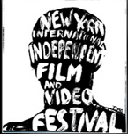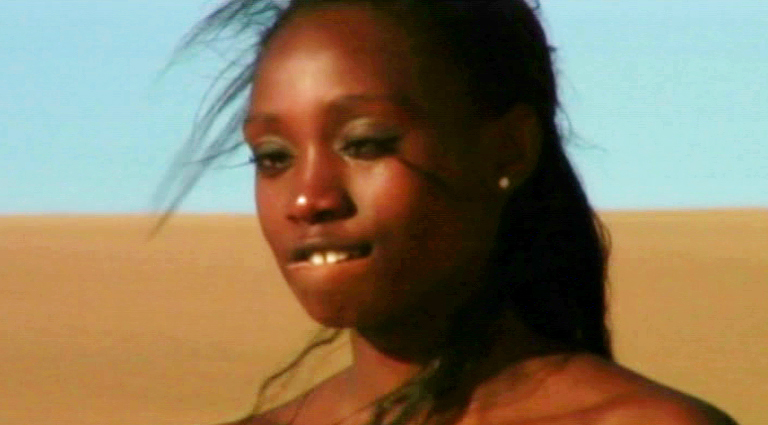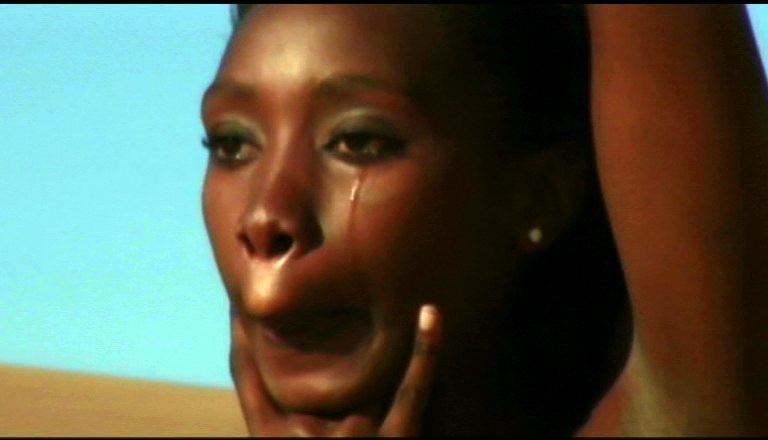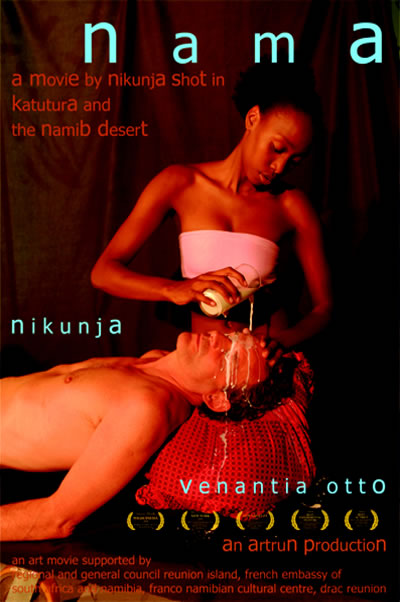
print presse francais 1 2 3 4 5 6 deutsch 1 2 3 nama meda list
radio interview france inter, cannes ; radio wave interview namibia ; rfi international (Dave Page live de Cannes)
tv rfo international parisphotos NYIFVF


AWARDS NYIFVF 2009
LOS ANGELES:BEST INTERNATIONAL ACTRESS, BEST EXPERIMENTAL FEATURE, NEW YORK: BEST DIRECTOR'S DEBUT


namaextrait1 from nikunja on Vimeo.
nameextrait3 from nikunja on Vimeo.
NAMA FULL ORIGINAL VERSION
The online quality is not ideal to really feel the material composition of the images as Nikunja treated them, but can at least provide a basic impression. Please get your dvd at artrun.fr@gmail.com
 |
| NAMA |
| Film-performance by Nikunja with African actress/model Venantia Otto selected for the International Filmfestival in Windhoek , Namibie from 3 April till 13th April 2008 invited by French Embassy South Africa and Namibia and French Institute, Namibia. La performance va être enregistrer entre le 22 et le 28 Février dans le désert de Namibie en coopération avec « Une autre Monde » Production de la Réunion , et Total Eclipse Films de l’Afrique du Sud. FilmPerformance to be shot and edited from 17th to 28th of February in Namibian Desert.Coproduced by Total Eclipse Films, South Africa; Une autre Monde, Ile de la Réunion “sometimes I am my mother and my father” «dès fois je suis ma mère et dès fois je suis mon père» |
| SYNOPSIS |
| This project is a (video)performance about film, about the research on the drama of human existence and the origins of human culture and man’s will to create., done by and through the eye of the film camera, which becomes the eye of the spectator. The performance is concerned about the Horizon, the horizon as a limit of individual and universal consciousness, as an orientation of individual and universal awareness and as an element between time and timelessness. The performer involves individual aspects of her life and of her culture, which are by nature linked to contemporary cultural awareness of today’s man. Through the setting on a circle in the location of the Namibian desert the individual is confronted to the universal, fashion to timelessness, the instant to the eternal, space to spacelessness. It is thus a project which links the existential to the philosophical, the spiritual to the mundane, and creates a specific awareness of the eye of the camera, as the centre of the being, the spectator, who will be watching this film. |
| PERFORMANCE LAYOUT |
| The lines on the body, the body as a line, as a horizon times (ages) and cultures, between the desert and the sky, between nothingness and existence.
Venantia in the desert in the circle, the circle of birth and death, the circle of reincarnations and the ancestors, the relation to the ancestors, the objects in this big circle, my body is my horizon, future and past are in the presence only in the immediate in the unavoidable Here and Now; again Patagonia, the dreamland, the escape from space and time; and the comprehension of the spiritual laws of nature as a whole. The universal body and the individual body of the person, Venantia; The Here and now of the realisation ultimate of the Human culture and will to art. WoMan in search of the horizon has to meet her origins, Nama, Nama at the border to nothingness. When woMan touches her horizon, she becomes her father and her mother; the origins and the ends join in the eternal NoWHere; now and here, nowhere. That is Venantia’s Circle in the Namib Desert. The circle is the temple of all WoMan. The dunes formed by the voices of the thousand winds since ever, the red and the blue and the black which are the circumference/aequators of the universe; the silence and the fall; substance and dissolution; nama is the origins of the creation of the laws of nature; the origins of the will to matter and existence; the songs of the winds; and thus their ends, their final beautiful breaths. The objects; the movements; the turning body like the derwish, changing expression as for the mask, changing costumes sometimes, then also expressions for the whole body, les grimasses du corps; The story to the object, the way it is being treated; what it expresses, where it is coming from; The story of the costumes, sometimes fragmented, is the story of time towards the timelessness of the human body. The man with the camera in the desert, crawling into the background of the dunes. He finds the circle of objects; the appearance of Venantia, the performer, who will act the story of the objects through the faces and body expressions she takes. The objects are linked to the performers relation to her mother and her father,who were born in two different tribes in Namibia. She will use impulsions from her perception of her mother or her father as the basis for the expressions she takes in her face or in parts of her body or with her entire body; The camera may follow the body movements or the movements of the objects or move by itself around the objects and the body; a choreography full of consciousness and of awareness towards the gestures and the mouvements it carries out; an important factor is the movement of and towards the horizon, which is the camera height towards the landscape, the objects and the body. The horizon is not always the horizontal line between earth and sky. The camera operates from with in a circle, sometimes as from a centre of a circle or as free moving point, changing height and closeness to the objects or body or face, but always in a circular movement from within the circle of objects. There is music to it, played on a small soundsystem just for inspiration; there will be another soundtrack on the final edit. Recordings of the natural sounds at location. This part is linked to Venantia’s role in the Maelfilm and relates to the origin of the will to create (art) as a means of enlarging perception as is unique to man and woman. The ending of that will is the death of man and human culture. The way the situation is being filmed is inspired by its content. Therefore the second small camera is important, too, to film the cameraman in the beginning. It is the eye of the spectator. It is being filmed by the crew who makes a film about my work, a “making of” as part of the film. The gestures of the performance are not symbolizing something, they stand for themselves with their cultural and spiritual impact. They do not need interpretation. They are the story in itself at that specific time and space. There is a link between the gesture , the object, the person and the landscape, an incarnated link, which does not require interpretation. The link is spiritual will according to the specific artistic and cultural content. |
| ABOUT |
| NAMA is a poetic and artistic movie about the search of mankind of his ultimate existential horizon. The will to create and to reflect on himself is unique to mankind. The origin and the death of human culture is directly linked to that will and power of creation.
The two protagonists, Venantia and Nikunja, a black woman and a white man, have two specific approaches in that resaerch, one representing an African or more original attitude and one representing a more Eurasian attitude. One linked to the spiritual connections and union to family and ancestors, as well as to the Other, the Foreign as such, the other more linked to battle, struggle and accomplishment, the self evaluation through separation, exclusivity and possessiveness. One linked to unbound territory, the other linked to territorial possession. One linked to the power of the individual, the other linked to the power of the group (not as social entity but as mass). Both are in search for their ultimate existential horizon, spiritually, physically, sexually, ideologically and emotionally. The two protagonists meet in the purified timeless location of the Namibian desert for a common ritual of purification, union and renewal. One representing the ultimate spiritually and physically fatal solution and conclusion of the genocide (in the film refering to the Namibian Herero), the other representing the all pervading compassion and union between all being. From this moment on in the movie, it is a common research, beyond these two opposing attitudes. A research which touches through different sequences the dream, the absurd, the creative ideal, and finally the common eternal voyage to the infinite transcendental beyond. From that turning point in the movie, the presence of the eye of the spectator in the image is always present. One camera is visible in the picture and the pictures it shoots as well. Thus it opens a perception for time and space relations, media relation, relation to the reality of the cinematographic work and interrogates the perception of the spectator.Thus the theme of the movie is being related to the spectator, his horizon and the history of his life. |
| CAST |
|
Actors Venantia Otto Agnes Otto Frans Otto Coralie Testan Nikunja Producer Artrun.fr prod Venantia Otto Nikunja Camera Venantia Otto Franck Alfirevic Johan Jooste Nikunja Editors Sakhe Jele Nikunja Sound Alain Perret Nikunja Soundremix Morena Mohobane With the kind support of French Embassy South Africa French Embassy Namibia Regional Council Reunion Island General Council Reunion Island French Namibian Cultural Centre Cultural Centre Village Titan, Reunion Island With many thanks to Vincent Garrigues Alma Otto Frank Alfirevic Terrence and Leizel Francis Tony Figueira Nicolas Doyard Françoise Kersebet Stephan and Juliette Demoulin Vanashree Singh Nadeema Parkins O Models Africa Nicolas M Couezou |